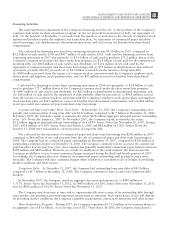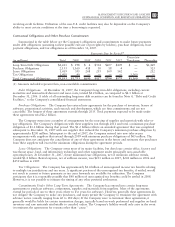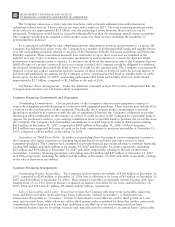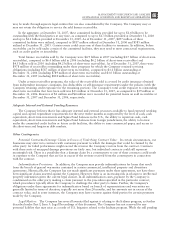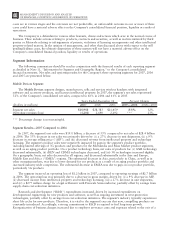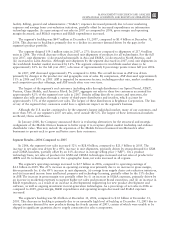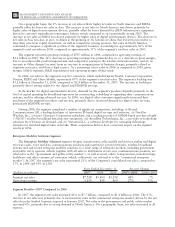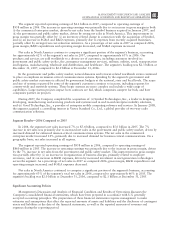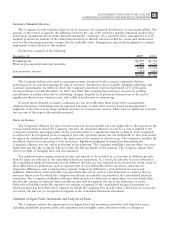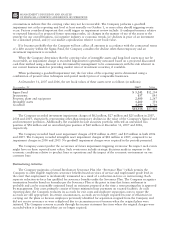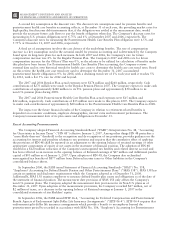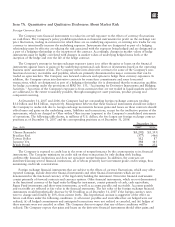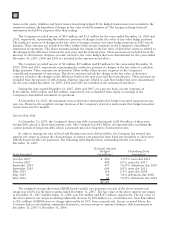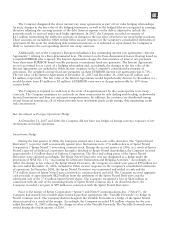Motorola 2007 Annual Report Download - page 71
Download and view the complete annual report
Please find page 71 of the 2007 Motorola annual report below. You can navigate through the pages in the report by either clicking on the pages listed below, or by using the keyword search tool below to find specific information within the annual report.
The segment reported operating earnings of $1.2 billion in 2007, compared to operating earnings of
$958 million in 2006. The increase in operating earnings was primarily due to an increase in gross margin in both:
(i) the commercial enterprise market, driven by net sales from the Symbol business acquired in January 2007, and
(ii) the government and public safety market, driven by strong net sales in North America. This improvement in
gross margin was partially offset by: (i) an inventory-related charge in connection with the acquisition of Symbol,
and (ii) an increase in SG&A and R&D expenses, primarily due to expenses from recently acquired businesses,
partially offset by savings from cost-reduction initiatives. As a percentage of net sales in 2007 as compared 2006,
gross margin, R&D expenditures and operating margin decreased, and SG&A expenses increased.
Net sales in North America continue to comprise a significant portion of the segment’s business, accounting
for approximately 62% of the segment’s net sales in 2007, compared to approximately 63% in 2006. Our
products and services are sold worldwide to a diverse set of customers, including customers involved in:
government and public safety (police, fire, emergency management services), military, utilities, retail, transportation
and logistics, manufacturing, wholesale and distribution, and healthcare. The segment’s backlog was $2.3 billion at
December 31, 2007, compared to $2.0 billion at December 31, 2006.
In the government and public safety market, natural disasters and terrorist-related worldwide events continued
to place an emphasis on mission-critical communications systems. Spending by the segment’s government and
public safety market customers is affected by government budgets at the national, state and local levels. The scope
and size of systems requested by some of the segment’s customers continue to increase, including requests for
country-wide and statewide systems. These larger systems are more complex and include a wide range of
capabilities. Large-system projects impact how contracts are bid, which companies compete for bids, and how
companies partner on projects.
During 2007, the Company completed the acquisition of: (i) Symbol Technologies, Inc., a leader in designing,
developing, manufacturing and servicing products and systems used in end-to-end enterprise mobility solutions,
and (ii) Good Technology, Inc., a provider of enterprise mobile computing software and services. In January 2008,
the segment acquired a controlling interest in Vertex Standard Co., Ltd., a global provider of two-way radio
communication solutions.
Segment Results—2006 Compared to 2005
In 2006, the segment’s net sales increased 7% to $5.4 billion, compared to $5.0 billion in 2005. The 7%
increase in net sales was primarily due to increased net sales in the government and public safety market, driven by
increased demand for enhanced mission-critical communications systems. The net sales in the commercial
enterprise market increased 14%, primarily due to increased demand for business-critical communications. On a
geographic basis, net sales increased in all regions.
The segment reported operating earnings of $958 million in 2006, compared to operating earnings of
$860 million in 2005. The increase in operating earnings was primarily due to the increase in gross margin, driven
by the 7% increase in net sales from the government and public safety market. This improvement in gross margin
was partially offset by: (i) an increase in reorganization of business charges, primarily related to employee
severance, and (ii) an increase in R&D expenses, driven by increased investment in next-generation technologies
across the segment. As a percentage of net sales in 2007 as compared 2006, gross margin, R&D expenditures and
operating margin increased, and SG&A expenses decreased.
Net sales in North America continued to comprise a significant portion of the segment’s business, accounting
for approximately 63% of the segment’s total net sales in 2006, compared to approximately 66% in 2005. The
segment’s backlog was $2.0 billion at December 31, 2006, compared to $2.1 billion at December 31, 2005.
Significant Accounting Policies
Management’s Discussion and Analysis of Financial Condition and Results of Operations discusses the
Company’s consolidated financial statements, which have been prepared in accordance with U.S. generally
accepted accounting principles. The preparation of these financial statements requires management to make
estimates and assumptions that affect the reported amounts of assets and liabilities and the disclosure of contingent
assets and liabilities at the date of the financial statements, as well as the reported amounts of revenues and
expenses during the reporting period.
63
MANAGEMENT’S DISCUSSION AND ANALYSIS
OF FINANCIAL CONDITION AND RESULTS OF OPERATIONS


